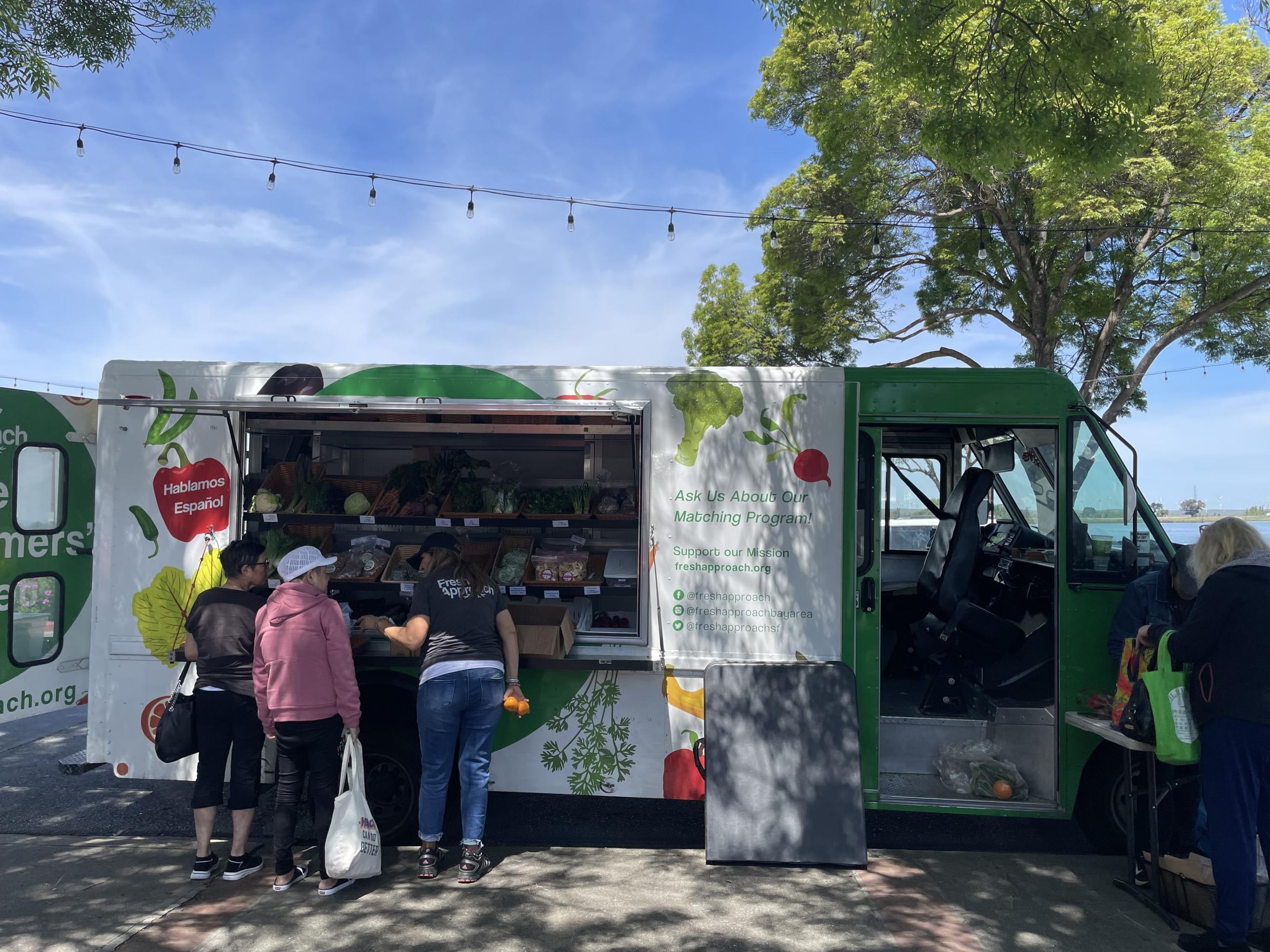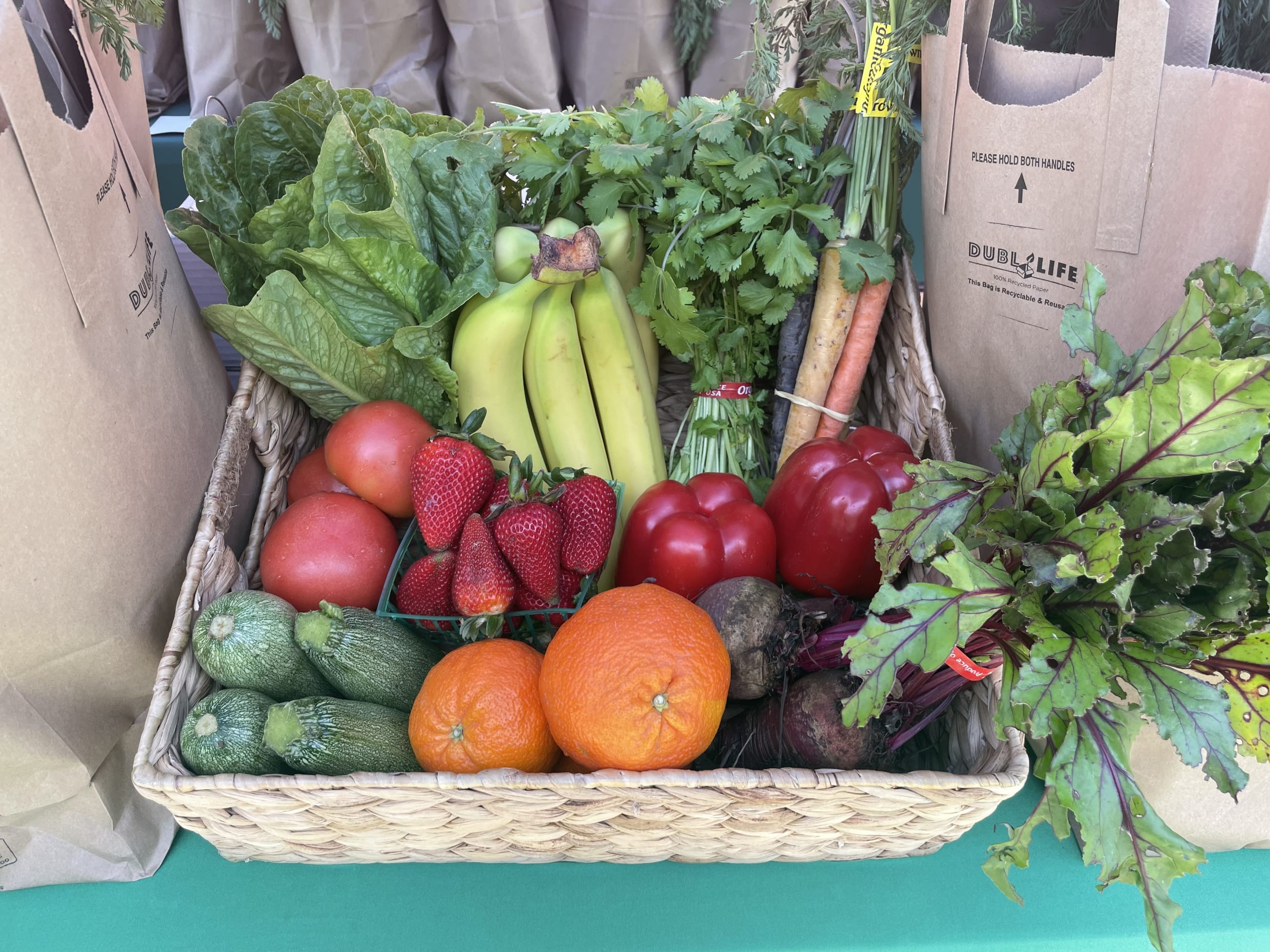On a sunny day in Clearwater, Florida, more than a dozen individuals gathered in a parking lot at a United Way resource center, eagerly awaiting the arrival of 360 Eats, a mobile food truck that serves weekly free meals from food that would otherwise be thrown away.
The two options that day were a pulled chicken bowl with fresh greens, pasta salad, and creamy salsa—or a seafood stew bowl featuring farm vegetables, creamy grits, and herb sauce. A woman in uniform, fresh off her shift from a nearby hotel, stood in the shade as another family bounced a squirmy toddler.
All the way across the country—in Antioch, California—a long line of customers waited for the Fresh Approach truck, a mobile farmers market bringing local and affordable produce to East Bay communities. Lettuce, leeks, mushrooms, and nuts dotted attractive baskets, and onlookers were abuzz over the huge, juicy strawberries that had just come into season.
More than delicious quests to find fresh produce, these experiences represent a novel project to elevate resilience and community in the fight against food insecurity. Supported by the American Heart Association's Social Impact Fund, 360 Eats and Fresh Approach are part of an effort of more than 100 programs aimed at addressing social determinants of health by making nutritious food accessible in underserved communities and tackling health disparities.
The new effort, which launched in 2018 and rolled out in 2023, aims to address knowledge gaps connected to food insecurity. Community-based programs certainly make an immediate difference in people's lives, but deeper understanding of their long-term impact on health is lacking.
The challenge lies in the resources and tools traditionally available to track their impact.
A simple yet innovative solution is to ask individuals straightforward questions about their fruit and vegetable consumption, which is linked to improved cardiovascular health. Despite its simplicity, this approach can yield insights comparable to national surveys and standardized health metrics. By integrating a few concise questions into their operations—perhaps through a quick survey while individuals wait in line—programs could begin to gather valuable data on the dietary habits of their customers.
This approach is more flexible, more efficient, and cheaper than traditional ways of tracking health impact, which often involve time-consuming or burdensome methods.
Additionally, engaging with stakeholders in the design and implementation of these evaluations ensures that the methods are relevant and respectful. By putting community members at the center of the evaluation process, tools can better measure the impact of these programs and guide future efforts to improve access to healthy food.
The Scale of Food Insecurity and the Impact of Community Support
Growing Together, another community-based partner in Richmond, California, sets up a stand with discounted farm boxes outside an elementary school at pick-up time. A mom, with a kid on each arm, explains that thanks to this program, her entire family is eating healthier and is exposed to produce that they wouldn't buy themselves:
I enjoy bringing my kids to see all the produce. I am happy because we didn't eat much fruit or vegetables at home because they were expensive, and I didn't have the time. But thanks to the vegetable bags they sell outside the school at an affordable price and variety, my whole family consumes more produce of higher quality.
In the United States, almost 42 million people (or 12.5% of the population) rely on Supplemental Nutrition Assistance Program (SNAP) benefits to buy groceries. Yet in food swamps, access to affordable, healthy food remains a significant hurdle and is more likely to affect communities with higher rates of poverty, those with greater proportion of people of color, and those in rural areas. These disparities contribute to health inequities and disproportionately affect marginalized populations.
Persistent barriers still prevent many individuals from eating healthier. The primary challenges among customers of 360 Eats, Fresh Approach, and Growing Together include affordability, time for preparation, and accessibility. These barriers intersect with broader social determinants of health such as economic security.
While waiting for their meals, customers talked about how this program made such a big difference to them. A woman in Clearwater explained that because of her chronic health conditions, her doctor put her on a strict diet, but she couldn't afford pricey fruits and vegetables and didn't have access to a kitchen to prepare healthy meals. Supplementing her diet with meals from 360 Eats meant that she knew she was eating healthy meals a few times a week; better yet, the meals were free. Another person loaded up a few meals on his bike and explained that he was taking them to his house-bound neighbors.
"I love that I don't have to travel to places that are far out in richer areas, that it's here for us who are income challenged and that we get a variety of healthy fruits and vegetables" said one Fresh Approach customer who lived around the corner from where the truck stopped. Because she didn't have a car, she explained, she was unable to access the grocery store a few miles away. Plus, the steep discounts Fresh Approach offers to individuals either eligible for SNAP or EBT, or on disability helped her lower her monthly grocery bill significantly.
Farmers' Challenges With Measuring Impact
At the heart of these community-driven efforts is understanding the true impact of programs from funding and policy perspectives. It's not just about the number of meals served or the pounds of produce distributed, but also the real-life changes happening with the individual recipients and their families.
Cameron Macleish, the founder and director of 360 Eats, describes the challenges and aspirations of capturing this impact.
"Our focus has primarily been on using this information to meet grant requirements, rather than conducting in-depth research," Macleish admits.
He underscores a common hurdle for small organizations: the daunting task of collecting meaningful data.
"I recognize the benefits of understanding the root causes of food insecurity in our community more deeply, but as a small organization, we currently lack the capacity to establish a comprehensive framework for such research."
Imagine if, along with serving meals, 360 Eats could quickly and easily gather insights into how these meals are changing dietary habits or improving health outcomes. Or if Fresh Approach and Growing Together could track the long-term benefits of increased access to fresh produce on the overall well-being of the communities they serve.
These insights could not only validate the work being done but also guide future initiatives, ensuring that they are effective and have as great an impact as possible.
The Future of Community-Based Research
In meeting communities where they are, community-based programs such as 360 Eats, Fresh Approach, and Growing Together not only provide immediate relief through access to nutritious food but also embody a larger movement toward health equity.
These stories—of individuals who, thanks to these programs, can now enjoy healthier meals and access fresh produce without financial strain—underscore the profound impact of community support. Such narratives of resilience and innovation highlight the transformative power of collective action in the face of food insecurity.
In the simple act of sharing a meal or a basket of fresh produce, these programs support stronger, healthier communities, demonstrating that the path to health equity is paved with the stories of those they serve.

EDITOR'S NOTE: We are unable to use real names or identifiable information in this piece to maintain the privacy of customers.












